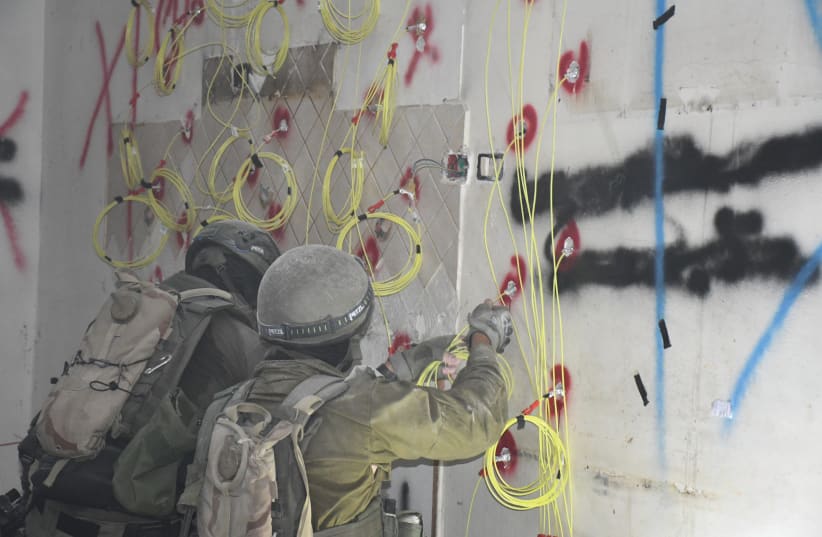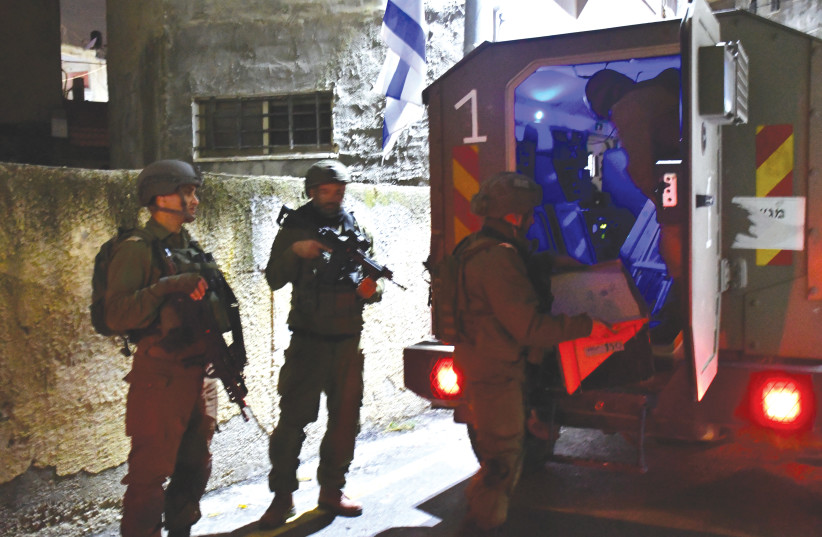This week I packed into a bus with IDF soldiers and drove into the West Bank as part of an operation. In this case we were heading to the village of Deir Ammar, in the rolling hills near Modi’in. The village was home to the perpetrator of a terrorist attack. The IDF was going to demolish the home of the terrorist.
This is a controversial tactic that the IDF believes is a tool that deters terrorism. Home demolitions date from the British Mandate. Israel didn’t invent them. When I got the opportunity to tag along and document the mission, I wondered what it would be like.
We began at a checkpoint near Rantis. It was dark, almost midnight. To get to the base I drove along Highway 1 from Jerusalem and then up into the hills above the ultra-Orthodox city of El’ad.
The hills here overlook the Coastal Plain. It is a reminder of how close the West Bank is to the heart of Israel. Everyone who understands how the rocket threat grew in Gaza after Israel left, now wonders: If Israel ever leaves these areas of the West Bank and Hamas takes over, won’t rockets launched from the West Bank target Israel’s populated areas?
The IDF operates in this area every night. I spoke to many soldiers during the five hours of the operation, and each described a high level of operations since October 7.
The soldiers were reservists. They had come to their unit from many backgrounds after the Hamas mass attack on October 7. One man was from Russia; he had just left the army in August before being called back. Another was an American who jokingly said he was “lost” and ended up here. In fact, he had been back in the country for vacation and decided to go to reserve duty. The men come from neighborhoods in Jerusalem, from near Haifa, and from all walks of life.
One of them was even from Gush Katif, before the Disengagement. He called it the “expulsion.” We’ve come full circle now in Gaza, and the IDF is back in control of areas it once controlled before 2005.
The roads here are dark. There is a small checkpoint and a military base. The soldiers received briefings on the raid. They also discussed the rules of engagement if they faced rioters. To get to Deir Ammar we had to drive a circuitous route. A bus full of soldiers, packed so tightly many had to stand, was escorted by several armored vehicles. One of them is the Sandcat Tigris, which doesn’t look like its name at all. It’s more like a vehicular version of an armadillo, with a large area in the back for soldiers to sit, and several seats up front for the drivers. It’s built for functionality, not comfort. The narrow seats give anyone who sits too long a cramp when they try to move. But it wasn’t as bad as being jammed into the bus, with no place to move.
Either way, the units got to where they wanted to go, but it took a while. Army operations always look good on paper, but in practice are much slower.
How does the IDF demolish the homes of Palestinian terrorists in the West Bank?
Soldiers gathered their gear, put on their helmets, checked their weapons, and made small talk. Some of the combat engineers on the mission, the men who would drill holes in walls and then blow up the house, looked at images of the house they had to target. The infantry soldiers spent time checking messages and watching TikTok videos. Some checked their backpacks to see if the water they were carrying was accessible. Each soldier still has gear they personalize – maybe gloves or the sling of their rifle. Armies are only uniform in a sense. On closer inspection everyone is different, even down to different helmets and different sights on their rifles.
On the way to the village the dark roads sometimes momentarily gave a view of an advertisement for land to buy here in one of the Jewish communities. Eventually, we got to the entrance of the village. Border Police officers had gone ahead to clear any rioters. Flames burned from a roadblock a few protesters had put up. The IDF does this at night to avoid friction with protesters.
The locals around the house had been evacuated. They knew this was coming. The home of the terrorist was just one floor. Everything had been removed already. It was just walls and some trash and a broken couch. One room seemed it had been a kids room, with drawings on the wall. On another wall, outside the house, there were two graffiti images of smiling kids. But this was not a time to smile.
The soldiers cleared the area and secured it, with different units fanning out. Then they brought up the Sandcat Tigris vehicles and unloaded explosives and tools. For three hours they drilled holes in the place, like it was a renovation. They had to be super precise to only destroy this one apartment in a multistory building.
AT THE time I didn’t know much about the terrorist whose house was being destroyed. I learned later this was the home of terrorist Daud Faiz, who carried out a ramming attack at the Maccabim checkpoint on August 31, 2023. The attack killed IDF Sgt. Maxim Molchanov and wounded others. The terrorist was able to flee initially toward the Hashmonaim checkpoint, where he was killed by troops. Molchanov was an oleh from Ukraine. He had been a bone marrow donor. When he was killed, I had been in touch with Chabad to reach out to his family, and I remembered reading about his funeral. He was a lone soldier.
Suddenly, the demolition assumed a very close proximity. It wasn’t a random terrorist or a questionable tactic. It had a very clear purpose.
It’s not clear whether the home demolitions work to deter terrorism. What I saw during the mission was how seriously the soldiers take their work of securing the West Bank. They usually do arrest raids, they said. This is only the second home demolition in months.
The operation of destroying the house is complex. They have to drill hundreds of holes in the walls but not damage the structure.
I asked why they can’t just use jackhammers to do this. The officer in charge, who is a combat engineer, was convinced this is the best method. However, when I saw the results, it was unclear to me whether this was the most efficient way of doing this.
If the structure isn’t destroyed, then the apartment can just be rebuilt with dry wall and blocks. It’s a renovation job. At least that’s what it seemed like. On the other hand, the disruption to the community and family surely sends a message.

